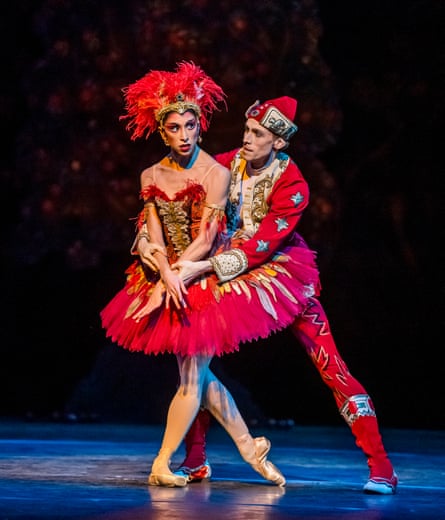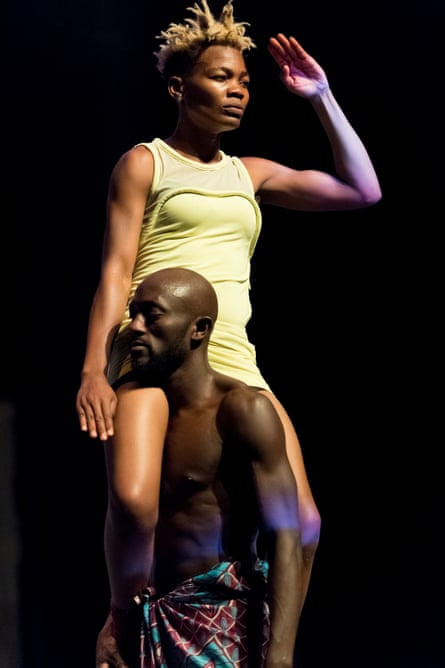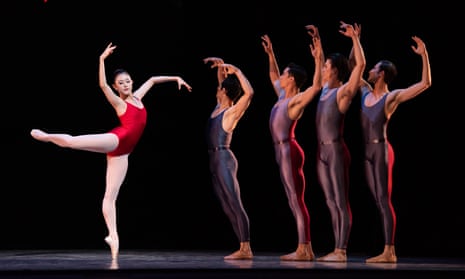One of the “attractions” of Sergei Polunin’s week-long run at the London Palladium – part of an epic week for London dance lovers – was an opportunity for mega-fans to go backstage for 10 minutes, to talk to their hero and take a selfie. They paid £400 for the privilege, and no doubt they felt it was worth it. They buy into the myth of the misunderstood, embattled genius.
But it is getting harder to see Polunin in that light. In his second programme he danced the title character in Rasputin, all staring eyes and despair in a new full-length piece for five dancers by Yuka Oishi that is full of emoting and not much else. Polunin’s innate talent, however ragged it now is round the edges, is not well served by a noisy (cacophonous score by Kirill Richter), empty work that requires so little of him. Oishi’s choreography is so thin it feels reductive; the chessboard setting by Otto BubenÍček looks like a throwback to the 1930s. The only moment that had any real impact was a tender healing duet with the young Tsarevich (Djordje Kalenic; wonderful).
With such fare, Polunin hardly furthers his aim “to evolve and integrate ballet into mass culture”. Ironically, it feels more old-fashioned in his hands than it does in the current triple bill being offered by his old alma mater the Royal Ballet. This opens with Fokine’s The Firebird, a ballet that, when premiered in 1910 by Diaghilev’s Ballets Russes, was as radical as they come with its stirring Stravinsky score. Over the years some dust has accreted on its fairytale storytelling, which involves an exotic bird, some enchanted princesses in their nighties, and an evil magician who keeps his soul in an egg in a box.

But to come to life, all ballet needs is skilful dancers who believe in what they are doing. On Wednesday, The Firebird looked gleaming new and thrilling, with Yasmine Naghdi’s fierce grace as the Firebird responding to the gentle valour of Edward Watson’s boy adventurer Tsarevich. The corps de ballet performed with compelling conviction and precision.
The same qualities of dramatic investment also illuminated a revival of A Month in the Country, in which Frederick Ashton compresses a five-act Turgenev play into 50 telling minutes, each of its stories of love and loss etched in solos and duets of expressive virtuosity. Here, Francesca Hayward and James Hay were particularly fine as the youngsters whose lives are wrecked by their mother Natalia’s love for the family tutor. He turned the boy’s show-off jumps into youthful high jinks; she registered every beat of hope and disappointment in lightly lyrical jumps and unfolding arabesques. The moment where Matthew Ball’s Beliaev lifts her in the air for the first time and she freezes with pleasure was worth a thousand words. Marianela Nuñez hasn’t yet found the desperate boredom that drives Natalia’s lunge for love, but she dances divinely, her shoulders and back rippling with passion, her duets with the excellent Ball quietly sexy and full of restrained longing.
The evening ended with Balanchine’s abstract Symphony in C, featuring some spectacular work from Vadim Muntagirov, two years behind Polunin in the Royal Ballet School. Although he is neither darkly handsome nor apparently troubled, if you want to see a classical dancer at the height of his powers, he’s the one to watch. But it’s unlikely anyone would pay £400 to meet him.
Few would shell out for 10 minutes in the company of the choreographer Alexei Ratmansky either, but if they did, it would be time well spent. He is one of the classical choreographers who is doing the most to advance the cause of ballet, and his Shostakovich Trilogy is a work of spine-tingling brilliance.

The first of four programmes of new work brought to the UK by the enterprising San Francisco Ballet, performing at Sadler’s Wells, it brings together three contrasting works – Symphony #9, Chamber Symphony and Piano Concerto #1, all played live by the Royal Ballet Sinfonia – and responds to their different moods with sensitivity and intelligence. Ratmansky is so full of ideas: whether it is the arm pumping, breezy attack of the boys in Symphony #9, or the sense of melancholy autobiographical struggle that animates Chamber Symphony, or the dipping little lifts that find the swoon in the sounds of the piano concerto, his rapturous inventiveness is so great, it is moving.
San Francisco’s second programme brought together three contrasting works, beginning with the muscular athleticism of Edward Liang’s The Infinite Ocean (a meditation on death), swooping through Cathy Marston’s darkly expressive take on Edith Wharton’s novel Ethan Frome, and ending with the bonkers pleasures of Arthur Pita’s bright and glittering Björk Ballet, which used the Icelandic singer’s songs as the jumping off point for a multi-hued, reflective whirligig of movement.
The dancers were superb in each contrasting piece. And the performers, all stunning, are what makes Serge Aimé Coulibaly’s Kalakuta Republik (at the Barbican, London, but soon to be seen at the Edinburgh festival) worth staying with. The piece itself, an examination of the influence of Fela Kuti, political activist and pioneer of Afrobeat, is confusing: I couldn’t decide whether it was a critique or entirely approving. But I was always interested in how the dancers moved, embodying many different techniques, from small mimetic gestures to expansive swaying, from tiny shoulder shudders to great hip-hop leaps. They are just great.
Star ratings (out of five)
Sergei Polunin ★
Royal Ballet ★★★★★
San Francisco Ballet ★★★★
Kalakuta Republik ★★★

Comments (…)
Sign in or create your Guardian account to join the discussion